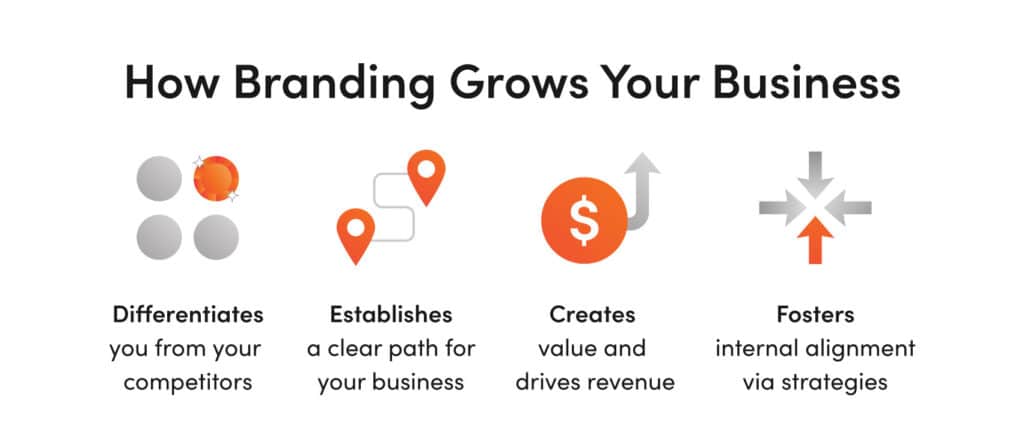A brand is more than just a logo. A brand is the narrative tool a business uses to emotionally connect with their target audience. Often overlooked, branding is an irreplaceable key to business growth.
Businesses tend to focus on the quality of their products or services — which isn’t a bad thing. But how will the product or service perform if your target audience has no desire to try it?
Branding creates value for customers. They aren’t just buying the product or service — they are buying the experience and the credibility. Branding communicates those unseen elements — through imagery, design, typography, messaging, language, packaging, and more. Customers want a brand that they understand. They want to make an emotional connection.
Branding in Action.
Starbucks is the ultimate example of branding success.
The business’s product doesn’t necessarily taste better than competitor brands, or generic homemade drinks. Even Starbucks lovers admit they produce an average cup of joe. Despite it all, Starbucks is the king of coffee across the globe. Everyone agrees, their success is due to their strong branding, which communicates value to customers no matter the location.
Early on, Starbucks identified a gap in the market and staked their claim. People wanted more than a drink, and that is what Starbucks would provide. They built their brand around selling relationships, community, and experiences — not just beverages. Their stores are designed to be a gathering space with feel-good music, warm delicious smells, your name handwritten on the cup, and a smile from the barista. Their brand presentation is clear and consistent, from the product photography, design and colors to their voice, messaging, and product names.
They grew from a single Seattle-based coffee bean dispensary in 1971 to a global icon in just 50 years. Even though the brand has come far since their Seattle days, their brand is still rooted in its origin story.
Customers connect with Starbucks’ humble beginnings and understand what the brand is all about. They know the brand is consistent. They know they can rely on it, anywhere they go. Customers are loyal to Starbucks. That is a sign of great branding.
Elements of Branding

Developing a brand strategy allows you to fine-tune your brand one piece at a time before putting it into action. Every brand strategy should include the following elements.
Brand Story. Brands use narratives to communicate to customers the essential moments of their origin, their core beliefs, and the business’s purpose. The story allows the business to establish why they exist, what they stand for, and what keeps them going. People connect with stories.
Brand design. A brand’s look is one of the quickest ways a customer can understand what they are all about — from colors to fonts to photography style. It communicates your brand’s point-of-view and taste level. Thoughtful design improves customer experience and differentiates a brand from its competitors.
Brand values. Customers want to understand why a brand exists. What matters to this business? What is their goal? What causes are they working to solve? Some brands take on social causes, which become essential to their branding, like the online clothing and accessory merchant Ivory Ella. The brand donates a portion of proceeds to Save the Elephants. Customers flock to the brand because it’s charitable, not necessarily because their product is superior to competitors.
Brand voice. The words, phrases, and tone brands use develops their personality and reflects their values. Brand voice communicates their role to the consumer: a light-hearted friend, a helpful neighbor, a reassuring doctor, or something else.
Brand Experience. The culmination of all your branding should put off a distinct energy, creating a desired feeling in your customer. Brick-and-mortar stores can curate the customer’s experience with music, smell, décor, employee interactions, and more. Online businesses can do the same with web design, social media presence, and customer communication.
The Key to Business Growth
To some, branding seems like an aesthetic effort, not a business choice. But branding is key to business growth. One study shows that a strong and consistent brand presentation across channels and platforms increases a brand’s revenue by up to 23%.
Here is how branding works to grow your business


Branding differentiates you from competitors. When you find a niche that is unfulfilled, you can take control of it. Once you proudly make that space your own, your competitor can’t take it. Customers will know you for who you are, instead of ignoring you as one in a million.
Branding establishes a clear path and a goal for your business. While developing your strategy, you confront the lingering questions of confidence you may have about your business. Establishing who you are and what you stand for can help create a clear path of growth for your brand; you know where you are, and you know where you are going. Your identity can inform and drive decisions and growth for the future. You won’t have to worry about floundering, unsure of where to take your brand. A brand strategy will make those decisions clear.
Branding creates value and drives revenue. The value of a product is in its perception. Imagine you are at a grocery store, looking at two indistinguishable jars of peanut butter when it comes to the recipe or product quality. The price point may not be the factor you use to decide which jar you get. You are willing to pay more for one, simply because you are familiar with the brand. The color of the label makes you happy, or you care about a social cause the company stands for. Those things are valuable to you and other customers. The business has increased the customer’s willingness to pay just by creating an emotional connection with the customer.
Branding strategies foster internal alignment. Brand strategies impact all areas of business, including internal structures and employee culture, which encourages business leaders to develop purpose-driven roles for their talent. Proud that their work matters, employees will be empowered to help drive the team to success. In contrast, employees at unorganized companies can feel lost because they lack connection or motivation. Ensure internal harmony by creating a brand strategy that fosters a cohesive, productive team.
Invest Branding + Business Growth
If you want to grow your business through branding, Matter can help. We help businesses of all industries establish their brand with research, copywriting, design, and more.
To learn more about Matter’s branding capabilities, visit our website or contact us for a consultation.

